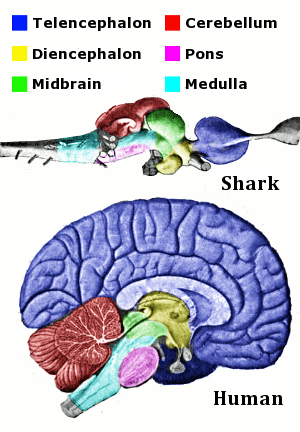| English: Main regions of the vertebrate brain, shown for a shark and a human brain (the human brain is sliced along the midline). The two brains are not on the same scale. (Photo credit: Wikipedia) |
-----
By JAMES GORMAN
The United States and the European Union have launched new brain research programs, part of a recent surge in studies. Scientists are mapping parts of mouse, fly and human brains at different levels of magnification. They have a greater understanding of how the brain works, such as the way mammalian brain navigates and remembers places, work that won the 2014 Nobel Prize in Physiology or Medicine.
Yet the growing body of data – maps, atlases and connectomes that show linkages between cells and regions of the brain – represents a paradox of progress, with the advances also highlighting great gaps in understanding.
So many large and small questions remain. How is information encoded and transferred from cell to cell or from network to network of cells? Science found a genetic code but there is no brain-wide neutral code; no electrical or chemical alphabet exists that can be recombined to say “red” or “fear.” And no one knows whether information is encoded differently in various parts of the brain.
Larry Abbott, 64, a former theoretical physicist who is now at Columbia University in New York, is one of the field’s most prominent theorists. He switched from physics to neuroscience in the late 1980s, after stopping by the lab of Eve Marder, a colleague of his at Brandeis University Massachusetts. Her lab was studying neurons that control a muscle in crabs. One of her students showed him equipment recording the electrical activity of neurons and translating it into clicks that could be heard over speakers each time a cell fired, or spiked. “It was the sound of those spikes that entranced me,” Dr. Abbott said.
Dr. Marder and Dr. Abbott invented the dynamic clamp technique, a way to link brain cells to a computer to manipulate their activity and test ideas about how cells and networks of cells work.
A decade ago, he moved from Brandeis to Columbia, where he and other scientists are trying to build computer models of how the brain might work. Single neurons, he said, are fairly well understood. The question now is how larger groups, thousands of neurons, work together – whether to produce an action, like reaching for a cup, or to perceive a flower.
There are ways to record the electrical activity of neurons in a brain, and those methods are improving fast. But, he said, “If I give you a picture of a thousand neurons firing, it’s not going to tell you anything.” Computer analysis helps to reduce and simplify such a picture but, he said, the goal is to discover the physiological mechanism in the data.
He recently worked with Nate Sawtell, a fellow Columbia researcher, and Ann Kennedy, a graduate student in Dr. Sawtell’s lab, on the weakly electric fish. Unlike electric eels and other fish that use shocks to stun prey, this fish generates a weak electric field to help it locate prey. Researchers have designed experiments to understand, up to a point, how its brain and electric-sensing organs work.
Dr. Abbott joined with others in the lab to take this understanding a step further. The fish has two sensing systems. One is passive, picking up electric fields of other fish or prey. Another is active, sending out a pulse, for communication or as an electrical version of sonar. They knew the fish was able to cancel out its own pulse of electricity by creating what Dr. Abbott called a negative image.”
-------------------
Could this be the cure for Alzheimer and Parkinson's disease?
-------------------
They wired the brain of a weakly electric fish and found that a surprising group of neurons, called unipolar brush cells, were sending out a delayed copy of the command that another part of the brain was sending to its electric organ. The delayed signal went straight to the passive sensing system to cancel out the information from the electric pulse.
“The brain has to compute what’s self-generated versus what’s external,” Dr. Sawtell said.
This may not sound like a grand advance, but it is the beginning of how a brain sorts a flood of data coming in from the outside world, and gives it meaning.
That is part of the brain’s job, after all – to build an image of the world from photons and electrons, light and dark, molecules and motion, and to connect it with what the fish, or the person, remembers, needs and wants.
“We’ve looked at the nervous system from the two ends in,” Dr. Abbott said, meaning sensations that flow into the brain and actions that are initiated there. “Somewhere in the middle is really intelligence, right? That’s where the action is."
Taken from TODAY Saturday Edition, The New York Times International Weekly, 22 November, 2014











No comments:
Post a Comment